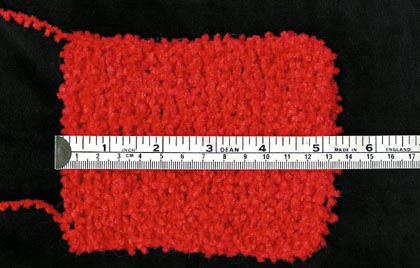3: Tension
(cont.)
Some textured yarns are almost impossible to count because the
lumps and bumps or hairs are very confusing. If you are following a
pattern, you will have the suggested tension stated at the beginning
of the instructions, but if you are making your own pattern, it is
crucial to know the exact size of the stitches.
Knit a specific number of stitches and rows. Measure the resulting
width and length, and, using a calculator, divide the measurements
by the number of stitches and rows that you have knitted. This will
give you the exact size of each stitch and you then multiply that by
the number of inches or centimetres that you wish to achieve. Round
up the number of stitches to the nearest sensible number [pic 4].

4: Although itís difficult to see actual stitches with a
yarn like this, knowing the number of stitches and rows you have
knitted will help you to calculate the size of the stitches.
The knitted piece above measures 13
centimetres across, and there are 20 stitches. Divide 13 centimetres
by 20 stitches and the size is 0.65 centimetres per stitch. Divide
the number of centimetres you require by the size of one stitch. If
you are intending to make something that is 65 centimetres wide,
then you will need 100 stitches. Using inches or finding the
required length in rows is calculated in the same way. If you have
fractions of stitches or rows, round up or round down the number to
the nearest sensible result.
---
Fine tuning your tension
So does tension really matter? Yes!
Especially when it comes to matching the suggested width in a
knitting pattern. If you have the right number of stitches, the rows
will usually be correct as well, just like magic. It is more
important to have the correct number of stitches in tension width
than rows, as all patterns state a specific number of stitches to
cast on, but many only suggest the measurement of the length to be
knitted.
If the required tension in a knitting pattern is 18 stitches to 10
centimetres but the tension of your knitting is 16.5 stitches to 10
centimetres, you will find that if the correct finished width
knitted on 90 stitches would measure 50 centimetres, knitting at
your tension would measure 54.5 centimetres. That means your garment
wonít be the size you have decided to make. Overall, it will be 9
centimetres or nearly 4 inches wider than you intended. A tiny
difference in tension multiplies into a huge difference over a large
number of stitches.
If you have less stitches than specified in the pattern, you are
knitting too loosely, and the finished garment will be too large.
Loose knitters also run the risk of running out of yarn, as they are
making a garment that is bigger and uses up more yarn. To get the
correct tension, try knitting more tightly (this is hard to do, you
usually slip back into bad habits), or use a smaller needle. If you
have more stitches than specified, you are knitting too tightly. Try
knitting more loosely, although, again, this is hard to keep up, or
use larger needles.
If you have had to adjust your knitting to get your required stitch
size, donít rely on needing to do the same with another yarn. Always
make a tension square for each different yarn.
Whether you change your knitting style or your needle size, or even
if your tension square is correct, occasionally check the tension on
your knitting. Sometimes you can relax and start knitting
differently to the way you began.
NEXT
PAGE >> chapter
page: 1 | 2 |
3 |